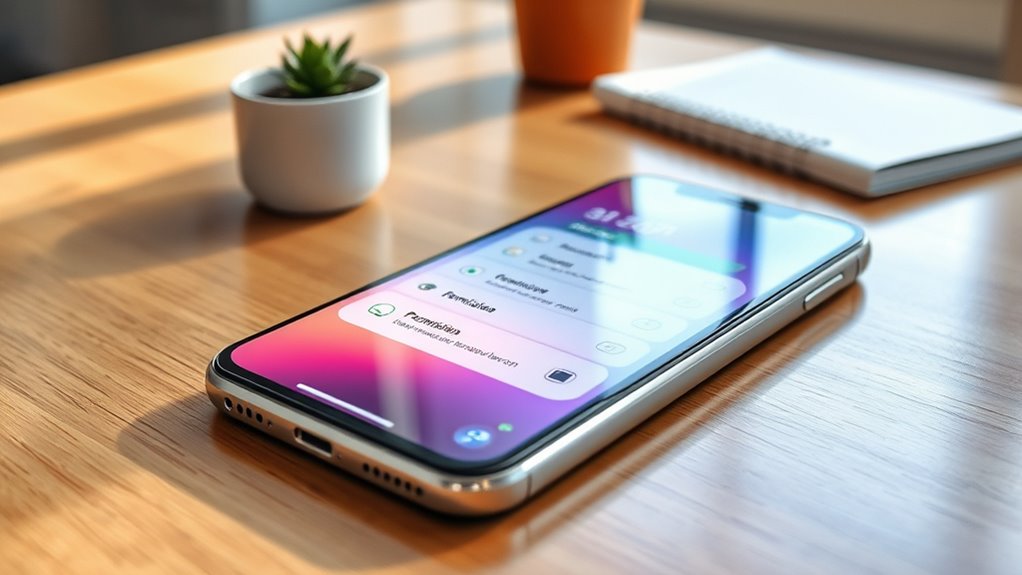Today, you can revoke permissions like location access, camera, microphone, contacts, and photo permissions for many apps on your devices. On smartphones, go into settings or privacy options to disable any permissions that aren’t necessary. For browsers and online platforms, review and adjust site permissions, clear cookies, and disconnect third-party app access. Taking these small steps can markedly boost your privacy—stick around to find out more ways to protect your digital life.
Key Takeaways
- Review and revoke app permissions on your smartphone for location, camera, microphone, contacts, and photos.
- Manage browser permissions to block third-party cookies and restrict site data access.
- Check and disable unnecessary permissions in social media and online platform settings.
- Remove connected apps and revoke access via your Google or Apple account settings.
- Regularly audit and adjust app permissions to enhance privacy and reduce security risks.

Have you ever wondered how many apps and services have access to your personal data without your knowledge? It’s a common concern in today’s digital world, where convenience often comes with a hidden cost. Many apps ask for permissions when you first install them, but you might not realize the extent of access you’ve granted over time. The good news is, you don’t have to accept this situation. You can take control by reviewing and revoking unnecessary permissions today. The first step is to check your privacy settings on your devices and within specific apps. These settings allow you to manage what data apps can access and how much control they have over your device. For example, on smartphones, you can limit app access to your location, camera, microphone, contacts, and photos. This isn’t just about privacy; it’s also about security. The more access you grant, the greater the risk if an app is compromised or behaves maliciously.
Review your app permissions regularly to protect your privacy and security.
To start, navigate to your device’s settings menu. On iOS, go to Privacy, then review each category—Location Services, Photos, Microphone, Contacts, and others. Disable access for apps that don’t need it or that you don’t trust completely. On Android, you can do the same via Settings > Privacy or Apps & Notifications, depending on your version. Here, you can see a list of apps and the permissions they’ve been granted. Turn off access for any app that seems excessive or unnecessary for its core function. For instance, a simple game probably doesn’t need access to your contacts or microphone. Additionally, understanding the contrast ratio of your projector can help you better appreciate how it renders images, especially in dark scenes, ensuring a more immersive viewing experience.
This process isn’t limited to your phone either. Web browsers also have privacy settings that control app access, cookies, and site data. Clearing cookies and adjusting site permissions can prevent websites and third-party services from tracking your activity. Many online platforms, like social media sites, also allow you to review and revoke app permissions in their settings menus. Regularly doing this keeps your digital footprint minimal and reduces potential vulnerabilities.
Revoking app access today can feel like a small step, but it profoundly enhances your privacy. It gives you peace of mind knowing you’re not sharing more than you intend. Plus, it helps prevent apps from collecting data for targeted advertising, profiling, or worse, data breaches. Staying proactive with your privacy settings empowers you to take back control of your digital life. Remember, permissions are there for your convenience, but they should never compromise your security. So, spend a few minutes now to review and revoke permissions you no longer need—your privacy will thank you.
Frequently Asked Questions
Can Revoking Permissions Affect App Functionality?
Revoking permissions can affect app functionality, especially if the app relies on certain permissions for features. You might experience limited access or app restrictions, but it also helps address privacy concerns. By removing unnecessary permissions, you reduce potential security risks. If you notice issues after revoking permissions, you can always grant them again. Prioritize your privacy by regularly reviewing and managing app permissions to balance functionality with security.
Are There Risks Involved in Revoking Certain Permissions?
Revoking permissions is like closing a window to your privacy concerns, but it can also block fresh air from your apps. Risks include limited functionality or app crashes if essential permissions are revoked. Carefully manage permissions to balance privacy and usability. Think of permission management as a delicate dance—step with caution to protect your data without disrupting your app experience. Always review what permissions are crucial before revoking them.
How Do I Identify Which Permissions to Revoke?
You should start by reviewing your device’s permission management and privacy settings. Check which apps or services have access to sensitive data or features, like location, camera, or contacts. Focus on permissions that seem unnecessary or outdated. Disable or revoke those permissions directly within your device settings. Regularly updating your privacy settings helps guarantee you’re only sharing info with trusted apps, reducing potential risks and maintaining control over your data.
Will Revoking Permissions Delete My Data?
Revoking permissions is like closing a door on unwanted guests; it won’t delete your data but keeps your privacy concerns at bay. When you revoke permissions, your data stays safe, but the app can no longer access certain info. This boosts your data security and peace of mind. Rest assured, revoking permissions is a smart move to protect your privacy without losing your valuable data.
Is It Possible to Restore Permissions After Revoking?
Yes, you can restore permissions after revoking them through permission management. When you revoke a permission, it’s often reversible by going back into your settings and re-enabling it. Keep in mind, restoring permissions allows apps or services to access features again, but it doesn’t automatically restore any previous data that was protected. Always review your permission management settings to ensure your choices align with your privacy preferences.
Conclusion
By taking a moment to revoke permissions today, you might just find a little more privacy and peace of mind. It’s funny how small actions can make a big difference, almost like a coincidence that’s been waiting to happen. So go ahead, check those settings, and revoke what you don’t need. In doing so, you control your digital space — and sometimes, it’s the simplest steps that lead to the biggest peace of mind.








